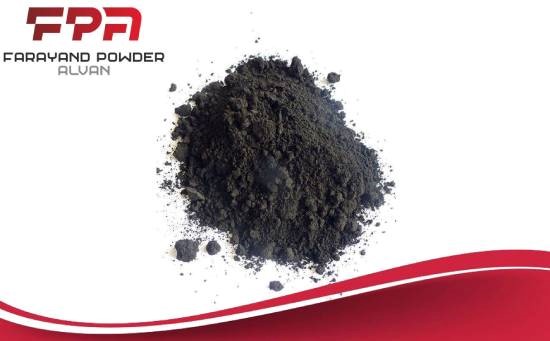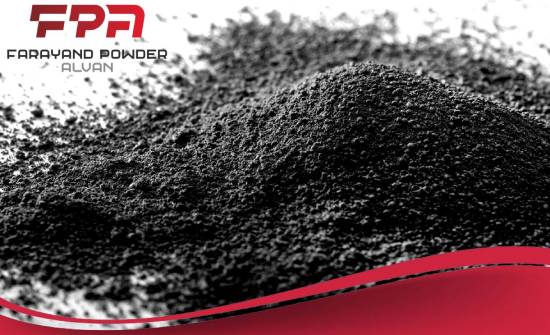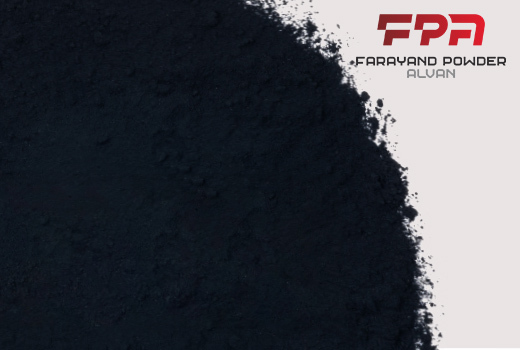Black pigment powder is a finely ground substance composed of dark-colored particles, typically used to impart a black color to various materials. It is commonly created by grinding black minerals or synthetic compounds into a fine powder form. Carbon black, a fine powder produced from the incomplete combustion of carbon-rich materials like natural gas or oil, is a widely used black pigment due to its intense darkness and durability.

Black pigment formula
After knowing what is black pigment, it is better to get acquainted with its formula. Black pigment is typically achieved through various compounds and materials that absorb most visible light, reflecting minimal colors. The most common black pigment is carbon black, produced by incomplete combustion of organic materials like oil or gas.
The black pigment formula is generally represented as C, denoting pure carbon. Another standard black pigment is iron oxide black, with Fe3O4 or FeO·Fe2O3, made from iron salts. Manganese dioxide (MnO2) and various carbon-based compounds also create black pigments. These materials absorb light across the visible spectrum, resulting in a deep black appearance, making them crucial in diverse applications like ink, paint, and plastics.

Black pigment benefits
when we know about carbon black formula and What is Carbon Black, we must understand its benefits. Here are some of the key advantages of using black pigment:
Aesthetic Appeal
Black is a versatile and timeless color that is widely used in the worlds of fashion, design, and art. It adds elegance, sophistication, and depth to products and spaces. Black pigment can create bold and striking visual effects in paints, inks, and dyes.
UV Protection
Black pigments can absorb and dissipate ultraviolet (UV) radiation. This property is valuable in products like sunscreen, clothing, and sunglasses, where protection from harmful UV rays is essential for skin and eye health.
Heat Absorption
Black materials have a high absorbance of sunlight and heat, making them ideal for applications like solar panels, where maximizing energy absorption is crucial. The black pigment can help increase the efficiency of solar energy collection.
Stealth and Camouflage
Black pigments are used for stealth and camouflage in military and aerospace applications. Black can help reduce visibility by blending with the dark surroundings or absorbing radar waves, making it harder to detect.

Conductivity
Some black pigments, like carbon black, are electrically conductive. This property is valuable in manufacturing components such as batteries, rubber tires, and electronic devices.
Uses of black pigment
black pigment or carbon black uses have been very common in the past. Here, we will explore what black pigment is used for and explain each of them.
Art and Painting
Black pigment is a fundamental color in the world of art and painting. Artists use it to create shadows, define shapes, and add depth to their works. It is commonly used with other colors to create a wide range of shades and tones.
Ink Production
Black ink, made from black pigments, is used in the printing and publishing industries for newspapers, books, magazines, and other printed materials. The rich contrast of black ink on white paper is a timeless choice for legibility and aesthetics.
Cosmetics and Personal Care
To enhance the eyes, black pigment is used in cosmetics such as eyeliner, mascara, and eyeshadow. It is also used in hair dyes and nail polish for a bold and dramatic look.
Textile and Fashion
Black pigment is crucial in the textile industry for dyeing fabrics and creating black-colored clothing and accessories. Black is a popular choice in fashion due to its versatility and classic appeal.
Automotive Industry
Black pigment is used in the automotive industry to produce black paint on cars and motorcycles. It is a common color choice for its sleek and elegant appearance.
Construction and Architecture
In construction, black pigment is used to produce black concrete and asphalt. It is also employed for architectural coatings and finishes, providing a modern and sophisticated look.
Inkjet and Laser Printing
In modern printers, black pigment-based ink or toner is used for high-quality text and image printing. It ensures sharp, crisp text and graphics.

Composition and Properties of black pigment
In this part, we will discuss how to make carbon black pigment. Carbon black pigment is typically produced through the incomplete combustion of hydrocarbon-based materials, such as natural gas or petroleum oil.
The process begins with introducing these hydrocarbons into a high-temperature reactor or furnace with a limited oxygen supply. As the hydrocarbons burn incompletely, they release carbon particles into the reactor. These carbon particles then aggregate and form tiny, highly structured particles. The resulting carbon black is collected and processed to remove impurities.
Carbon black side effects
Inhalation of carbon black particles, especially in high concentrations or prolonged periods, may lead to respiratory issues. These particles can be inhaled deep into the lungs, causing irritation, coughing, and exacerbating pre-existing respiratory conditions like asthma or bronchitis.
Additionally, long-term exposure to carbon black has been associated with an increased risk of lung cancer, particularly in individuals working in industries where they are consistently exposed to this substance without adequate protective measures.
Skin contact with carbon black may also result in minor irritations or allergic reactions, but these effects are generally less severe than respiratory issues. To mitigate the potential side effects of carbon black, it is essential to follow safety guidelines and use appropriate personal protective equipment when working with this substance.

Checking the important points for buying black pigment
Just as we need to know what is black pigment or what is Carbon Black, we should also pay attention to important points when buying this product. black pigment uses is always one of the important raw materials for many other products. So after knowing what is black pigment use for, it is better to pay attention to the following tips for buying.
Type of Black Pigment
The market offers different types of black pigments, such as carbon black, iron oxide black, and organic black pigments. Carbon black is popular for its deep black color and excellent UV resistance, while iron oxide black is known for its heat resistance. Organic black pigments are synthetic and provide versatility in application. The selection should align with the specific requirements of the intended application.
Application and End-Use
Understanding the intended application is crucial. Different industries have varied requirements for black pigments. For instance, the demands in the automotive industry may differ from those in the cosmetics industry. Consider the desired properties like opacity, color strength, and chemical resistance, and ensure they align with the end-use requirements.
Color Stability
The stability of the black pigment over time is essential, especially in applications where long-term color retention is critical. Factors such as exposure to light, heat, and chemicals can affect the color stability. Ensure that the chosen black pigment can withstand the environmental conditions to maintain the desired appearance over the product's lifespan.
Particle Size and Distribution
The particle size of the black pigment influences its dispersion, color intensity, and overall performance. Smaller particles generally contribute to better dispersion and color development. Analyzing the particle size distribution is crucial to achieving consistent and uniform results in the final product.

Dispersion Properties
The ability of the black pigment to disperse evenly in the medium is vital for achieving uniform color. Poor dispersion can lead to issues like color variations and reduced product quality. Evaluate the dispersion properties of the pigment and consider factors such as surface treatments that may enhance dispersion.
Compatibility with Medium
Black pigments need to be compatible with the medium in which they are dispersed, whether it's a liquid, powder, or paste. Compatibility issues can lead to settling, poor adhesion, or other performance issues. Assess the compatibility of the pigment with the chosen medium to ensure optimal performance.
Regulatory Compliance
Compliance with regulatory standards and guidelines is crucial, especially in industries such as cosmetics and food packaging. Ensure that the chosen black pigment meets the regulatory requirements in terms of safety, toxicity, and environmental impact.
Cost Considerations
While quality is paramount, the cost of the black pigment is also a significant factor. Evaluate the overall cost-effectiveness, considering factors such as pigment concentration, coverage, and long-term performance. Striking the right balance between quality and cost is essential for a sustainable and profitable production process.
Supplier Reputation
Choosing a reputable and reliable supplier is key to obtaining a consistent and high-quality black pigment. Research suppliers, consider their track record, and seek recommendations from industry peers. A trustworthy supplier ensures a stable supply chain and reduces the risk of product inconsistencies.

Farayand Powder Alvan Co. is a trusted supplier with 30+ years of expertise in manufacturing industrial micronized powders. Our seasoned team boasts extensive pigment knowledge, making us a reputable choice across diverse industries. We take pride in offering customers top-quality products and valuable technical guidance, ensuring optimal and cost-effective solutions for their needs.


